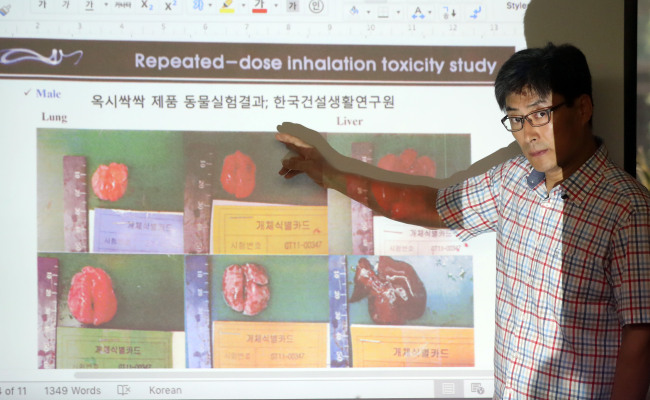Some of the victims and members of civic group have dismissed the government’s additional confirmation of 37 victims of toxic humidifier disinfectants, arguing the state’s categorization process is flawed.
Based on the third round of victims’ damage reports collected last December, the Environment Ministry conducted the verification process on 165 out of 752 applications for recognition as victims, based on personal clinical results, diagnostic images and the level of exposure.
Among them, 35, including 18 deaths, were confirmed as category 1-2 victims eligible for government care. Two victims who raised objections after the second round of verifications in April 2014 were also confirmed as category 2 victims.
However, members of a group of victims and their families known as Gapimo and the Asian Citizens Center for Environment and Health argued that the government’s standard for recognizing the victims of toxic disinfectant was unfair. They also charged that the government did not consider victims suffering from other long-term health illnesses and underlying diseases.
According to the government’s victim verification process, which was introduced in 2014 to provide due compensation and medical treatment, the scale goes from 1-4. A rating of 1 indicates a high level of certainty that their lung diseases were caused by the use of humidifier disinfectants.
The ministry-run Korea Environmental Industry and Technology Institute explained that those who suffered lung-related diseases are classed as category 1 or 2 victims, while those with other respiratory-related diseases fall into categories 3 and 4.
 |
Choi Ye-yong, head of Asian Citizen’s Center for Environment and Health, speaks during the press conference in Seoul on Friday. (Yonhap) |
“The government still left some 130 people out, with 50 percent of them being put as category 4, a group that cannot even receive health monitoring from the government,” said Choi Ye-yong, head of ACCEH, during a press conference in Seoul on Friday.
The ACCEH also argued that the government has so far put more victims into categories 3 and 4 than categories 1 and 2.
In the first round of victim verifications in June 2013, 184 victims were confirmed as categories 3-4, whose health conditions were recognized by the government. After the second verification process in April 2014, 69.2 percent or 117 victims were put into categories 3-4. On Thursday, the ratio of categories 3-4 victims went up to 79 percent or 130 victims.
“The government defines category 4 victims as those whose health problems have almost no connection with the use of humidifier disinfectants. There were three category 4 victims who passed away but are still listed as alive on the government record,” said Choi of the ACCEH.
“This is because the government ignored the severity of the victims’ health conditions and did not conduct in-depth investigations into their health,” added Choi.
Victims also argued that deaths of infants, victims with blood-flow disorders and a mother who had a stillborn child -- all confirmed as category 4 -- should be reconsidered. They argue they should be reclassified as categories 1-3, to at least receive state care and contribute to understanding the relationship between the use of humidifier disinfectant and other diseases.
However, the ministry has so far deferred their decision to revise the standard by which victims are verified, sticking to categorizing victims by disease.
“We will consider establishing an additional standard to find the relationship between the use of toxic disinfectant and diseases other than lung-related diseases,” said Seo Heung-won, director of the Environment Health Policy Division under the Environment Ministry.
The ministry said that it would soon conduct another verification process regarding the remaining 587 victims who filed reports in December.
But the number of victims is likely to increase as the government started receiving a fourth set of applications in April. A total of 3,031 cases have been filed as of Friday.
The humidifier disinfectant case came to light after four pregnant women died of unidentified lung-related diseases in 2011. A state-led investigation later confirmed a connection between at least 100 lung-related deaths and the chemicals used in humidifier disinfectants.
By Kim Da-sol(
ddd@heraldcorp.com)








![[Today’s K-pop] Blackpink’s Jennie, Lisa invited to Coachella as solo acts](http://res.heraldm.com/phpwas/restmb_idxmake.php?idx=644&simg=/content/image/2024/11/21/20241121050099_0.jpg)